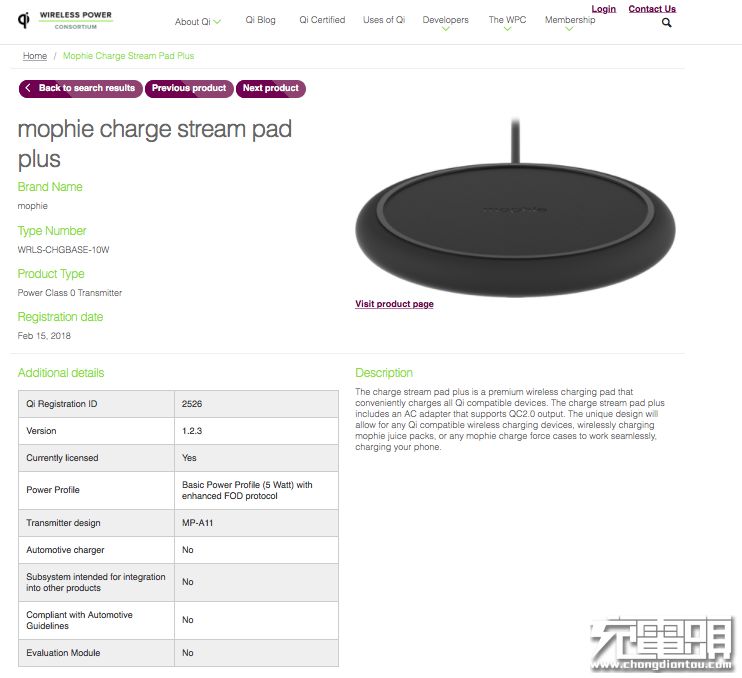

In terms of apple 7.5W transmitter authentication, compared with Qi v1 2.3,Qi v1. 2.4 the following updates are available:
1. The TX type mp-a11 is in Qi v1 2.4 formally incorporated into Qi standard.
2. In Qi v1 Under version 2.3, this kind of transmitter has passed the BPP FOD extensions certification, while in the newly released Qi v1 Under 2.4, the certification level of the transmitter is simplified and will pass EPP (mp-a11) certification.
To sum up, after the new protocol is enforced, the type of Qi authentication that apple 7.5W transmitter needs to pass is EPP (mp-a11).
Interpretation of market wireless charging transmitter scheme
At present, wireless charging transmitters in the market are mainly divided into two categories:
The first type is the medium and low-end transmitter, and the adopted schemes are frequency conversion architecture and constant frequency and duty cycle architecture.
The working principle of the frequency conversion architecture is to adjust the transmission power by changing the working frequency, which will cause some interference to the mobile phone circuit in some transmission frequency bands. At present, transmitters with frequency conversion architecture in the market generally adopt a11 or a11a, which can only pass BPP certification. The power of this kind of transmitter is generally greater than 5W and less than 10W. There is no Q-value detection circuit. In terms of FOD (metal foreign matter detection) performance, it is significantly inferior to the transmitter that has passed the BPP FOD extensions and EPP certification scheme.
Some transmitters support Apple's 7.5W fast charging by adjusting the duty cycle at a fixed operating frequency on the basis of a11 / a11a. The transient response of this architecture is poor. Based on this architecture, the transmitter generally does not have Q-value detection circuit, which is poor in FOD detection, does not meet the EPP requirements, and cannot pass the EPP certification. As a Chinese innovation, the fixed frequency and duty cycle architecture is superior in high cost performance. To a certain extent, it can also enable users to enjoy Apple's fast charging experience at a lower price, but it can not achieve zero interference to mobile phones. More importantly, it does not comply with the MFI specification and does not belong to a standard architecture of Qi. It may not meet the more stringent fast charging requirements put forward by Apple mobile phones in the future, and it is more likely to fail to pass Apple certification in the future.
The second type is the transmitter represented by Apple 7.5W, which adopts constant frequency and voltage regulation architecture.
Constant frequency and voltage regulation is the standard scheme officially designated by apple. The 7.5W fast charge proposed by Apple at the MFI conference adopts the architecture of constant frequency and voltage regulation. Mp-a11 topology is adopted, the working frequency is fixed at about 127khz, the duty cycle is constant at 50%, and the transmission power is controlled by adjusting the voltage. It can effectively avoid interfering with the frequency band of the mobile phone and minimize the interference of wireless charging to the mobile phone. With Q-value detection circuit, it will be more sensitive in FOD detection and meet the requirements of EPP. The scheme can be certified by BPP, FOD extensions and EPP. In WPC Qi v1 2.4 after implementation, it shall be uniformly classified as EPP certification. Representatives of manufacturers of fixed frequency and voltage regulation schemes on the market include NXP, IDT and easy impact wireless (CPS).
At present, apple 7.5W transmitters with large-scale modulus and constant frequency and voltage regulation architecture are known in the market. In addition to mophie and Belkin officially recommended by apple, there are ravpower, spigen, Anker, etc. The first two adopt NXP scheme, The latter three adopt easy impact wireless (CPS). As the official supplier of Apple's wireless charger, NXP is naturally the benchmark of the constant frequency and voltage regulation scheme. Of course, the cost will be relatively high. As a leading enterprise in the industry, Yichong wireless in China is the most widely used 7.5W constant frequency scheme products and is also widely used in the first-line brands. As for IDT, it is reported that it has also launched relevant products recently, and I believe it will be available soon The market will enter the next round of competition. At the same time, it is found that there is an updated mophie second-generation transmitter on the certified product page of WPC's official website. This transmitter is a constant frequency and voltage regulation architecture and supports apple 7.5W fast charging. It is said that the solution provider has changed from NXP to easy impact wireless.

Firstly, in terms of authentication, the wireless charging power of mobile phones on the market is generally higher than 5W, generally 7.5W or 10W, so the transmitter scheme needs to pass Qi v1 2.4 EPP certification. The second is the scheme. Because we need to pay attention to the performance of charging stability, charging efficiency, FOD and interference to mobile phones, Apple's 7.5W fast charging product had better choose the architecture transmitter scheme of constant frequency and voltage regulation specified by apple.
Summary:
Apple's new machines are equipped with wireless charging, which completely detonated the market. Subsequently, LG, Nokia, Sony, Jinli, Xiaomi, Huawei and other manufacturers have or will follow up this technology, and this wave is unstoppable. Predictably, Qi v1 The release of version 2.4 will further standardize the wireless charging market and promote industrial upgrading. Apple 7.5W wireless charging products on the market will be equipped with mainstream constant frequency and voltage regulation schemes.

XINSPOWER GROUP LIMITED
Shenzhen Xinspower Technology Co.,Ltd
Add:Building 2, Xinhao Second Industrial Zone, Qiaotou Community, Fuhai Street, Baoan District, Shenzhen
Tel:+ 86 755-23500826
Fax:+ 86-755-23500926
E-mail: gm@xinspower.com (General manager)